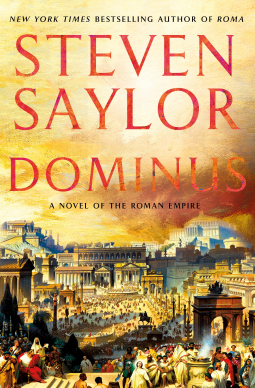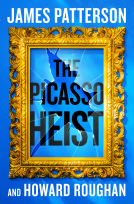
Dominus
A Novel of the Roman Empire
by Steven Saylor
This title was previously available on NetGalley and is now archived.
Send NetGalley books directly to your Kindle or Kindle app
1
To read on a Kindle or Kindle app, please add kindle@netgalley.com as an approved email address to receive files in your Amazon account. Click here for step-by-step instructions.
2
Also find your Kindle email address within your Amazon account, and enter it here.
Pub Date Jun 29 2021 | Archive Date Jul 13 2021
Description
Following his international bestsellers Roma and Empire, Steven Saylor's Dominus continues his saga of the greatest, most storied empire in history from the eternal city at the very center of it all.
A.D. 165: The empire of Rome has reached its pinnacle. Universal peace—the Pax Roma—reigns from Britannia to Egypt, from Gaul to Greece. Marcus Aurelius, as much a philosopher as he is an emperor, oversees a golden age in the city of Rome. The ancient Pinarius family and their workshop of artisans embellish the richest and greatest city on earth with gilded statues and towering marble monuments. Art and reason flourish. But history does not stand still.
The years to come bring wars, plagues, fires, and famines. The best emperors in history are succeeded by some of the worst. Barbarians descend in endless waves, eventually appearing before the gates of Rome itself. The military seizes power and sells the throne to the highest bidder. Chaos engulfs the empire.
Through it all, the Pinarius family endures, thanks in no small part to the protective powers of the fascinum, a talisman older than Rome itself, a mystical heirloom handed down through countless generations.
But an even greater upheaval is yet to come. On the fringes of society, troublesome cultists disseminate dangerous and seditious ideas. They insist that everyone in the world should worship only one god, their god. They call themselves Christians. Some emperors deal with the Christians with toleration, others with bloody persecution. Then one emperor does the unthinkable. He becomes a Christian himself. His name is Constantine, and the revolution he sets in motion will change the world forever.
Spanning 160 years and seven generations, teeming with some of ancient Rome’s most vivid figures, Saylor's epic brings to vivid life some of the most tumultuous and consequential chapters of human history, events which reverberate still.
Available Editions
| EDITION | Other Format |
| ISBN | 9781250087812 |
| PRICE | $29.99 (USD) |
| PAGES | 496 |
Average rating from 14 members
Featured Reviews
Could this be the final Steven Saylor novel? Saylor has hinted that since he’s turned 65, he’s ready for retirement.
Saylor is known for his impeccable research and his unique ability in reconstructing history. This compelling capstone of the trilogy recounts the fortunes of the Pinarius family from the reign on Marcus Aurelius to Constantine. Spanning 160 years and covering 7 generations, Dominus begins at the height of Rome’s empire. It has reached its pinnacle and expanded boundaries while dealing with wars, plagues, fires and famines. Where book one featured the founding of Rome and book two featured the emperors, this book features the rise of Christianity and the manner in which the emperors accepted it. Some tolerated Christianity and some induced persecution. The novel concludes with Constantine, the emperor known for altering history by making Christianity the state religion of Rome. His vision included one empire, one people and one god. He hoped that everyone would pull together toward a single purpose, decided by their emperor and inspired by the Christian god. If you have been following the trilogy, the Pinarius family continues to endure due to the fascinum and for the first time this protective talisman gets into the hands of those other than family. The epilogue highlights the intriguing final days for the fascinum.
Reading this book during the pandemic, I was most interested in the arrival and spread of the plague. There was a ban put on gladiator games and other forms of group entertainment in an effort to cut down on transmission. Just as our economy was affected, the quarries came to a standstill and marble became as scarce as gold. Saylor recounts how usually the lowly slaves in the quarries were easily replaced, but when they died by the hundreds and thousands, even the quarries were depopulated. He pointed out that when the plague got out of control, there was an increased loss of manpower. We might be griping and complaining about services only open to curbside or take out, but in ancient Rome there were no slaves to harvest crops, so they rotted in the fields and the cargo sat on piers because there were no slaves to load the ships. Saylor explains that when trade trickled and there were no crops, it gave rise to famine.
This book cover features the beautiful painting, The Martyrdom of Saint Agnes, by Joseph Desire Court.
I was gifted this advance copy by Steven Saylor, St. Martin’s Press and NetGalley and was under no obligation to provide a review.
Publishes June 29, 2021.
 Paula C, Bookseller
Paula C, Bookseller
Steven Saylor never disappoints with his amazing stories set in ancient Rome, this title lives up to his reputation as one of the greats!
Saylor takes you on a multi generation journey, following the Pinarii family through the ups and downs of life in ancient rome. War, peace, heartache, joy, political/religious turmoil, and everything in between. There is a definite military and political focus which is exactly the kind of stories I enjoy.
Even if you've never read a book by Mr. Saylor I highly suggest you pick this title up, just be prepared to go on a spending spree when you pick up all his other books.
Saylor’s Third Historical Tome on Ancient Rome
This is the third large scope historical novel on ancient Rome. The story continues shortly after the previous historical novel stops with the reign of dual emperors Marcus Aurelius and Lucius Verus, and it ends with emperor Constantine leaving Rome in 326 CE after a short visit to celebrate his twenty-year anniversary as emperor. As with the first two novels, this is not a comprehensive historical series like Colleen McCullough's Masters of Rome series. This novel continues to be told through the eyes of the current members of the Pinaria gens, a real patrician family that originated long before the founding of Rome. Essentially, it is a series vignettes of the events of the times, about the current emperors, and the role of seven generations of the Pinarii have in those events.
The span of Roman history, with which I am most familiar, is from the consulships of Gaius Marius through to the reign of Domitian. That made this novel particularly desirable to read. I was not disappointed. In addition to the vignettes providing an overall flavor especially political of the times, there is the story of the Pinarii, the author includes little stories that add a richness to the novel. An example occurs with the first Pinarii in the novel who befriends the famous Greek physician, Galen who gives a demonstration called the squealing pig. I looked that one up on the Internet and discovered that it was true, albeit not exactly as written in the novel. Another such story that I particularly enjoyed was incorporating into the novel an explanation for an early 2000 archeological discovery in Rome. These little stories and facts appear throughout the entire novel.
Now, this is a novel of the Roman Empire, and there is content that raise red flags so readers be forewarned.
This novel is long but not a difficult read. The three major threads captured and maintain my interest throughout the novel. This is my primary criterion for a high star rating.
There was only one scene that the author let an answer to a question not be revealed to the readers. This is historical fiction, so why snub the readers? Does this happen in real life? All the time but it does not need to happen in fiction.
The ending left me hopeful. Constantine tells the current members of the Pinarii family that they are to accompany him to Constantinople to build churches. There were other conditions but I will leave those for you, the reader, to discover. This implies that this series can continue with the Byzantine part of the Empire in the future. That history is rich and over a thousand years long. I can wait. The only downside is that the last novel was published almost 11 years ago. I hope that it will not be that long for the next novel.
This novel can be read without reading the previous two. Based upon my enjoyment in reading the novel and on how well the author weaves history into the storyline through the perspective of Pinarii, I rate this novel with five stars.
I received a free e-book version of this novel through NetGalley from St. Martin's Press with an expectation for an honest, unbiased review. I wish to thank St. Martin's Press for the opportunity to read and review this novel early.
 Judy F, Reviewer
Judy F, Reviewer
This is another spectacular book by Steven Saylor. I have read so many of his books, and enjoyed every one. His research is so thorough and he includes so much historical detail in his books. This book felt so relevant to our current times, from the ongoing plague crisis that they dealt with to the dysfunction of the ever changing leadership. I learned so much about the final emperors, especially Constantine, and was surprised how many there were and how quickly they were replaced (well usually murdered). All of his books can be appreciated both for the historical accuracy as well as the engaging story and the way that he weaves them together. I am so grateful to St. Martin's Press for allowing me access to the ARC of this amazing book.
 Shirley W, Reviewer
Shirley W, Reviewer
Dominus is the final chapter in Saylor’s ambitious and impressive trilogy on ancient Rome. The first volume, Roma: The Novel of Ancient Rome, covers Rome for the first thousand years. Empire carries the story through Hadrian’s reign, at the height of the Roman Empire. Dominus begins during the time of Marcus Aurelius, the philosopher king, and ends with the reign of Constantine, when Christianity became the state religion.
In lesser hands, this could have been a dry history lesson, but Mr. Saylor is both a scholar and a stellar novelist. The story is told through the eyes of generations of the Pinarius family, a dynasty of skilled artisans whose skills provide them close contact with the many rulers through the centuries. Their fortunes ebbed and flowed with those of the rulers, who ranged from the wise and kind to the violent and mad. The family lives, and dies, through plagues, fires, and warfare, through intrigues and betrayals, making history come alive on the page.
Mr. Saylor has dedicated Dominus to all his readers throughout the years, and indicated that this may be his final novel. If it is, it is the jewel in the crown of a magnificent career.
 Jean K, Reviewer
Jean K, Reviewer
From the reign of Marcus Aurelius to Constantine, Steven Saylor continues the story of Rome through the Pilarius family. Their story began in Roma with the founding of of Rome and continued in Empire. In AD 165 Senator Lucius Pinarius was raised with Marcus Aurelius and now serves as his friend and advisor. Lucius’ wealth comes from the statues and monuments that he has designed and erected to honor the gods and rulers of the empire. With the death of Marcus he continues this work with his son Gaius in service to Commodus. Through plagues, fires, wars and the rise of Christianity, the story of Rome is seen though the eyes of generations of the Pinarii.
As Saylor progresses through the various rulers of Rome, Dominus feels like a series of short stories. Through it all, the family possesses the fascinum, an heirloom passed to the eldest son in each generation that is believed to protect the family. Through gladiatorial games and assassinations, it is sometimes a dark, yet fascinating history that engages your imagination as Saylor takes you through the senate, palaces, arenas and temples of the early Roman empire. I would like to thank NetGalley and St. Martin Press for providing this book for my review.
Readers who liked this book also liked:
Rachel Joyce
Historical Fiction, Literary Fiction, Women's Fiction
Jenny O'Brien
General Fiction (Adult), Historical Fiction, Women's Fiction


















